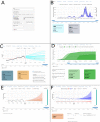Forecasting local hospital bed demand for COVID-19 using on-request simulations
- PMID: 38044369
- PMCID: PMC10694139
- DOI: 10.1038/s41598-023-48601-8
Forecasting local hospital bed demand for COVID-19 using on-request simulations
Abstract
Accurate forecasting of hospital bed demand is crucial during infectious disease epidemics to avoid overwhelming healthcare facilities. To address this, we developed an intuitive online tool for individual hospitals to forecast COVID-19 bed demand. The tool utilizes local data, including incidence, vaccination, and bed occupancy data, at customizable geographical resolutions. Users can specify their hospital's catchment area and adjust the initial number of COVID-19 occupied beds. We assessed the model's performance by forecasting ICU bed occupancy for several university hospitals and regions in Germany. The model achieves optimal results when the selected catchment area aligns with the hospital's local catchment. While expanding the catchment area reduces accuracy, it improves precision. However, forecasting performance diminishes during epidemic turning points. Incorporating variants of concern slightly decreases precision around turning points but does not significantly impact overall bed occupancy results. Our study highlights the significance of using local data for epidemic forecasts. Forecasts based on the hospital's specific catchment area outperform those relying on national or state-level data, striking a better balance between accuracy and precision. These hospital-specific bed demand forecasts offer valuable insights for hospital planning, such as adjusting elective surgeries to create additional bed capacity promptly.
© 2023. The Author(s).
Conflict of interest statement
The authors declare no competing interests.
Figures







References
-
- Li, R. et al. The demand for inpatient and ICU beds for COVID-19 in the US: Lessons from Chinese cities. medRxiv 2020.03.09.20033241. https://www.medrxiv.org/content/10.1101/2020.03.09.20033241v2 (2020). - DOI
-
- Emanuel, E. J. et al. Fair allocation of scarce medical resources in the time of covid-19 (2020). - PubMed
-
- Covid-19 dashboard by the center for systems science and engineering (csse) at johns hopkins university (jhu). https://www.arcgis.com/apps/dashboards/bda7594740fd40299423467b48e9ecfi. Accessed: 2023-07-06.
MeSH terms
Grants and funding
LinkOut - more resources
Full Text Sources
Medical

